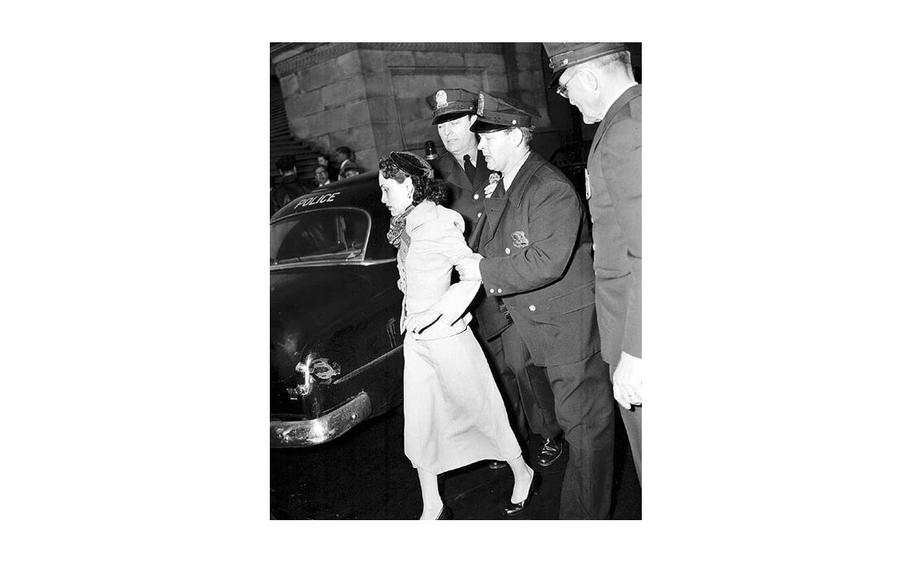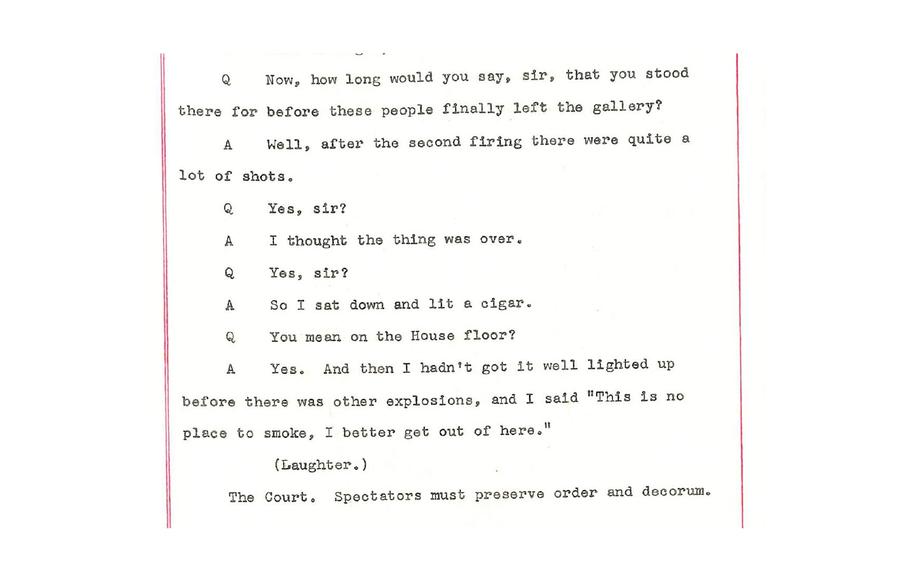
Police lead away Puerto Rican nationalist leader Lolita Lebron on March 1, 1954, following her arrest in the shooting of five congressmen in the House of Representatives. (WikiMedia Commons/Library of Congress/AP)
On the afternoon of March 1, 1954, Dolores “Lolita” Lebrón was seated in the U.S. House of Representatives visitors gallery, just behind the speaker’s chair. She leaped up suddenly, shouted, “Viva Puerto Rico libre!” and waved the flag of her homeland in one hand as she fired off a Luger pistol in the other. Her three companions — Rafael Cancel Miranda, Andrés Figueroa Cordero and Irvin Flores Rodríguez — followed her cue and opened fire into the chamber below, sending bullets audibly whizzing by heads, pockmarking seats and tables with holes.
The four members of the Puerto Rican Nationalist Party injured five congressmen. Rep. Alvin M. Bentley, R-Mich., was the most gravely wounded, surviving a punctured lung and shattered liver. The attackers were arrested and later convicted of assault with intent to kill and seditious conspiracy.
The periodic acts of violence by Puerto Rican nationalists in the 1950s aimed to draw attention by any means necessary to the half-century-long controversy over the island’s status and to pressure the U.S. government to grant it independence. They failed, but their impact on American democracy is still felt today.
On the 70th anniversary of the 1954 assault on the Capitol, their case has taken on greater significance as the Justice Department has prosecuted hundreds of participants in the Jan. 6, 2021, riot at the Capitol — some under the same statute used against the nationalists — and has also cited United States v. Lebron.
The events of March 1, 1954, were substantially different from the short-lived riot of Jan. 6, as were the motives of the attackers. But legally, there are distinct parallels. Both episodes were defined by violent acts seeking a political outcome, and both interfered with an official proceeding in the U.S. Capitol.
Nearly 3,000 pages of stenographer’s minutes from the two trials of the nationalists, unearthed from depths of the National Archives, reveal details that have been largely forgotten, despite the newfound relevance of their cases.

An excerpt from the stenographer's minutes of the trial of Puerto Rican nationalists who attacked the U.S. Capitol on March 1, 1954. ()
During court proceedings, witnesses described waves of firecracker sounds, muzzle flashes and gun smoke. Plaster rained down like bits of paper, one congressman testified, after slugs from Lebrón’s pistol hit the ceiling. Rep. Kenneth A. Roberts (D-Ala.) felt a “burning sensation” near his knee, saw blood and hollered, “I am hit.” A colleague peeled off his necktie to use as a tourniquet on the 41-year-old congressman.
Rep. Ben F. Jensen (R-Iowa), a member of the House Appropriations Committee who relished his efforts to limit the federal payroll, was shot from behind and immediately assumed he was being assaulted by a political enemy, since he’d been “outspoken against people who I thought were trying to destroy our way of life.” In testimony, he described how “the instant I was struck […] I said, ‘He got me.’” Jensen never shared which “he” had been on his mind.
Rep. Usher L. Burdick (R-N.D.) thought the attack was over after the first wave of shooting and glibly lit a cigar in the middle of the House floor, only to run off when gunshots broke out again. Rep. Louis E. Graham (R-Pa.), who was frozen in place, got a chilling view of Flores while standing below. “I am as sure as I will meet my God that he was pointing [a gun] towards me,” Graham told a Washington, D.C., jury. Flores, whose weapon jammed shortly after the attack started, threw his gun down, ran out of the building and attempted to buy a bus ticket out of town before he was apprehended by the police.
Shocked spectators in the vicinity of the attackers leaped into action and tried to pinion them, guns still in hand. W. Swem Elgin, a House gallery doorman who confronted Lebrón, told the court that “she fought like a tiger.” John E. Connolly, an NBC news editor working in the House’s radio gallery that day, testified that a frenzy ensued outside the chamber, with people shouting as they attempted to subdue the rest of the Puerto Ricans.
None of this was part of the nationalists’ plan. A note pulled from Lebrón’s purse read, “My life I give for the freedom of my country.” Cancel Miranda, whose train ticket from New York to Washington was one-way like those of his companions, said that he couldn’t believe their own bodies weren’t “riddled with bullets” by U.S. Capitol Police.
After they had been arrested and questioned at the police precinct, all four were charged. By mid-June, they had gone to trial and were found guilty of assault with a deadly weapon. Three were also convicted of “intent to kill”; the uncertainty about whether Lebrón had pointed her gun up in demonstration or down toward the well of the House got her acquitted of that charge.
After the convictions in Washington, federal prosecutors with the Southern District of New York linked Lebrón, Cancel Miranda, Figueroa Cordero and Flores with 13 other nationalists in an indictment for seditious conspiracy — a crime codified in a statute after the Civil War that made it illegal to overthrow or oppose the authority of the U.S. government by force. Prosecutors alleged that since 1950, they had schemed and then attempted to “oppose, overthrow, put down and destroy by force the Government of the United States.
“Throw the Yankees out at pistol point. Revolution,” said U.S. Attorney J. Edward Lumbard, painting a picture of the defendants’ alleged fanaticism for the jury. “Give your life and your property for independence. All tyrants are condemned to death, be he a Truman or a congressman.”
The government built an argument with evidence including weapons purchases, courier networks and fiery party rhetoric. The cornerstone of Lumbard’s case rested on two people with close ties to the nationalists: a secret FBI informant named Raymond Sanchez Sorrell and Lebrón’s own brother, Gonzalo Lebrón Sotomayor, who flipped on the nationalists after turning himself in to authorities.
In the end, prosecutors convinced the jury there had been a conspiracy. The rejection the next year of the nationalists’ appeal to a federal circuit court sat quietly in the books until another national trauma at the Capitol decades later.
In the seven decades since, when federal prosecutors have charged people with seditious conspiracy, the profile of the accused has varied. Jacob Schulz, a former Lawfare editor who has written about the 1954 case, said that before Jan. 6, 2021, the government had been “relatively unsuccessful” when using the law against right-wing groups. Prosecutors found more success, he said, against al-Qaeda-linked groups and even won convictions against later Puerto Rican groups that continued to be radicalized by the island’s controversial status.
“This is the eternal question and the eternal issue for Puerto Ricans,” said Rep. Nydia M. Velázquez (D-N.Y.), the first women of Puerto Rican descent to be elected to Congress. She played a major role in a 2022 bill that would have allowed voters on the island to choose among statehood, free association and independence in a referendum. The bill passed the House that year but stalled in the Senate.
“El estatus lo afecta todo,” she said — status affects everything.
During cross-examination in the D.C. case, U.S. Attorney Leo A. Rover asked the Spanish interpreter to ask Flores, “Why did he not use blank cartridges for this demonstration?” Flores responded, “Because when the United States went into Puerto Rico they did not use blank cartridges,” referring to the U.S. invasion in 1898. Rover asked Cancel Miranda whether he thought someone could have died in what the nationalists were calling a “demonstration.” “I know that the bullet can make damage,” Cancel Miranda replied in imperfect English. “I know that true from your government” — a possible reference to the 1937 Ponce massacre, in which local police, under the authority of the U.S.-appointed governor, brutally killed nearly 20 people, including women and at least one child, at a peaceful demonstration.
Many in the United States simply didn’t understand the grievance, said Margaret Power, author of the book “Solidarity Across the Americas: The Puerto Rican Nationalist Party and Anti-Imperialism.” The attitude of many mainland Americans, she said, was: “The nationalists must be crazy to go against the world’s most perfect democracy and not to want to be part of it.”
In some ways, the nationalist case was less complicated to prosecute than the Jan. 6 cases. In the years since the 2021 attack, prosecutors have dealt with hundreds of defendants from all walks of life and a variety of right-wing groups with different stated aims. But all shared the goal that day of stopping the certification of Joe Biden’s win in the 2020 presidential election.
In the aftermath of Jan. 6, Schulz published an article detailing how the 1954 sedition case and its Second Circuit opinion could “fortify the constitutionality of the [sedition] statute” and help the Justice Department pursue pro-Donald Trump conspirators. With a limited number of seditious conspiracy cases to look to, the Puerto Rican nationalists held particular significance.
One high-profile Jan. 6 prosecution, of Oath Keepers leader Stewart Rhodes, cited the 1954 case. When Rhodes’s counsel made a failed motion to dismiss the case against him, Judge Amit P. Mehta’s denial included a footnote referring to United States v. Lebron to refute the argument. The footnote also mentioned a 1955 House Judiciary Committee report, following the attack the year before, recommending an increase in the maximum penalty for the seditious conspiracy statute from six years in prison to 20 — a measure the House passed the next year. Rhodes received an 18-year sentence.
Graduate student Robert Johnson at the University of Missouri at Kansas City contributed to this report.